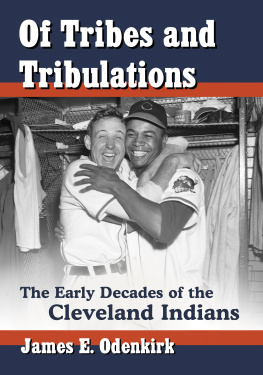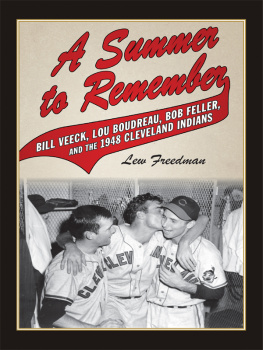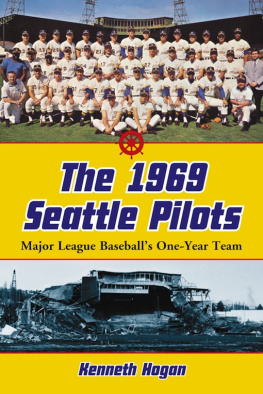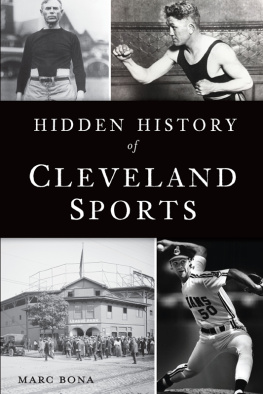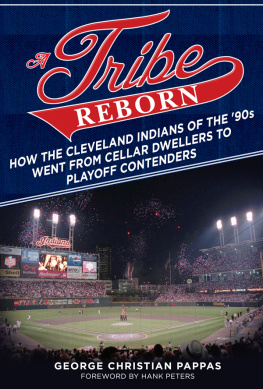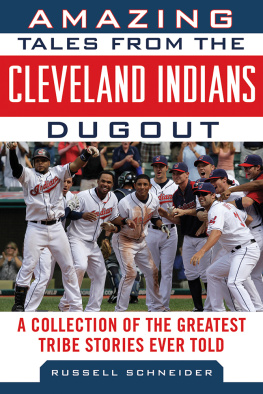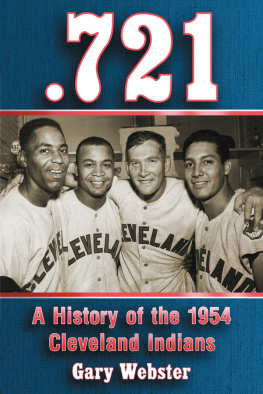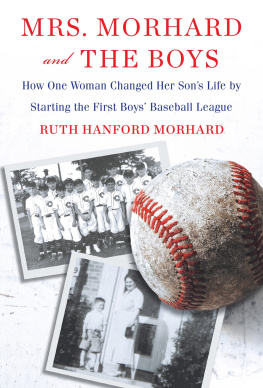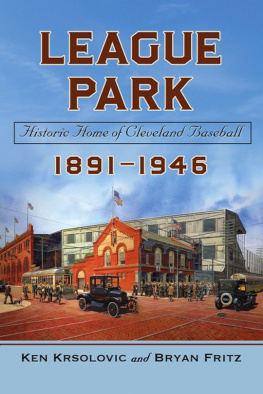
Of Tribes and Tribulations
The Early Decades of the Cleveland Indians
James E. Odenkirk

McFarland & Company, Inc., Publishers
Jefferson, North Carolina
LIBRARY OF CONGRESS CATALOGUING DATA ARE AVAILABLE
BRITISH LIBRARY CATALOGUING DATA ARE AVAILABLE
e-ISBN: 978-1-4766-1706-0
2015 James E. Odenkirk. All rights reserved
No part of this book may be reproduced or transmitted in any form or by any means, electronic or mechanical, including photocopying or recording, or by any information storage and retrieval system, without permission in writing from the publisher.
McFarland & Company, Inc., Publishers
Box 611, Jefferson, North Carolina 28640
www.mcfarlandpub.com
To BenitaAs Bill Veeck once said
not because I should
but because I want to, always and forever
Acknowledgments
It is imperative that I recognize and thank those who provided assistance in the long haul to the finish line. Among them are the staffs of the LIBRARY OF CONGRESS, Cleveland Public Library, Western Reserve Historical Society, Arizona State University, Cleveland Baseball Heritage Museum, National Baseball Hall of Fame, and the Society for American Baseball Research Library. I relied heavily on the collections of these institutions, guided at times by their helpful librarians, archivists, employees and volunteers.
Cleveland sportswriters were cooperative in providing behind-the-scenes anecdotes about the Cleveland Indians, particularly Russell Schneider and Hal Lebovitz of the ClevelandPlain Dealer and Bob August of the ClevelandPress. The following players and club officials were kind enough to grant interviews: Bill Veeck, Bob Feller, Lou Boudreau, Ray Boone, Harmon Killebrew, Tommy Henrich, Hal Trosky, Jr., Herb Score, Jimmy Dudley, Roland Hemond, and Gabe Paul.
Many professional associates, friends, and family members gave encouragement and professional assistance: Lee Lowenfish, Monte Poen, Bob Boynton, Maynard Brichford, John Toland, Morris Eckhouse, Stephanie Liscio, Jim and Linda Kearney, Bob Osterhoudt, Bill Witty, Gerry Soule, Bryce and Lu Gochner, Dale Stadtmueller, Steve Gietschier, Larry Gerlach, my sister Barb and her husband, Al Wadley, and my Wooster, Ohio, connections Harry and Betty Weckesser, Al and Judy VanWie, and Donald Demkee. Last, but not least, my two sons, Tom and Jim, who were baptized Indians fans.
Special thanks are due Fred Schuld, a loyal Indians fan and baseball scholar, and baseball writer Russell Schneider, both of whom provided important materials to help with my research, as did Jacob Pomrenke, web editor/producer for the Society for American Baseball Research. My good friend Gary Krahenbuhl provided invaluable help in preparing and collating photos included in this book. Special thanks go to historians Larry Gerlach and Charles Alexander, author and lawyer Rick Huhn, and sportswriter Russell Schneider of the ClevelandPlain Dealer for reading my manuscript and providing important suggestions.
Not enough praise and thanks can be given to my editor, Dr. Kathy Harris, professor emeritus, Arizona State University, who has helped me with many other published papers and one other book.
Finally, to my wife, Benita, untold appreciation for her patience, valid suggestions (among them, Dont write another book!), and skill in typing the manuscript from my long-hand writing. This book is dedicated to her.
Finally, any inaccuracies or errors interpreting the Tribes history are mine alone and I take full responsibility.
Preface
Jim Bouton noted in closing his best seller, Ball Four, You spend a good bit of your life gripping a baseball and in the end it turns out that it was the other way around all the time. For some, the relationship with the national pastime was a product of childhood; others embraced baseball later in life. For better or worse, they are bonded to the game. True fans become daily purveyors (and proofreaders) of box scores. They are hopefully addicted to green grass and blue skies, and each spring are seduced by the Sirens song, This is the year that were gonna win the pennant. The description fits this author.
This book is the product of a lifetime of experiences. First and foremost, it is a matter of loyalty, the kind of behavior which eventually leads to one being defined by Webster as a fanatic, someone who is unusually enthusiastic and overly zealous. Growing up during the Great Depression, I was exposed to the rooting interests of members of my immediate family. My mother, sister, uncle, and grandfather were Indians fans, but my father chose to be contrary, supporting the Detroit Tigers and Pittsburgh Pirates. It is recorded in my senior yearbook at Ontario High School that I would become the groundskeeper for the Cleveland Indians.
It was an era when fans could not easily attend games, but rare car trips from our home in Mansfield, Ohio, to League Park and Municipal Stadium solidified my support for the Indians. And each season the radio broadcasts by Jack Graney and Jimmy Dudley over stations WTAM, WHK, WJW, and WERE provided exciting information about games and players which intensified my imagination and interests. A brief tryout with the Tribe in 1950 as a young 22-year-old and with Hall of Famer Tris Speaker standing by, exciting if unsuccessful, personalized my identification with the team.
Then there was the written word that kept fans informed about the happenings in both leagues. Primary sources were The Sporting News, the Bible of Baseball, the red-covered Baseball Magazine, and Whos Who in Baseball. Cleveland newspapers and the Akron Beacon Journal were the principal sources of game coverage of team activity. The inside scoop was covered by Franklin Whitey Lewis and Frank Gibbons of the Cleveland Press, Ed McAuley of the Cleveland News, and Gordon Cobbledick of the Cleveland Plain Dealer, and of course there was the local MansfieldNews Journal. It was simpler, more focused time when baseball was not yet influenced by television broadcasts, player unions, and agents, convoluted and expanded schedules, and league expansion and playoff games.
But it was my career as a sport historian that prompted me to undertake this book project. I came to appreciate the need for historical, not just contemporary journalistic accounts of teams, people and episodes that form the world of sport. There have been many fine books written about various Indians players and events by noted historians and journalists, including Charles Alexander, Gordon Cobbledick, David Fleitz, J. Thomas Hetrick, Hal Lebovitz, Terry Pluto, Russell Schneider, John Sickels, and Gary Webster, to name a few. (I am grateful to other Tribe writers whose work appears in the bibliography.) But team histories are lacking. Franklin Lewiss popular The Cleveland Indians (1949), part of the Putnam team series, covers the first 50 years without references or endnotes. Endless Summers: The Rise and Fall of the Cleveland Indians by Jack Torry, former columnist for the Columbus Dispatch, treats the period from 1956 to 1994.
The most important motivation for this book was to research and write a history of the Cleveland Indians for the first half-century, from the founding of the franchise in the 1890s to the glory days of the late 1940s and early 1950s. This required extensive research in national and local newspapers published over the seven decades, perusal of numerous baseball and sports magazines, and innumerable interviews with individuals knowledgeable about the Indians. Hopefully, my literary contribution to Cleveland Indians history proves to be a valuable resource for researchers, authors, and readers interested in the Tribe and baseball in general.
Next page
